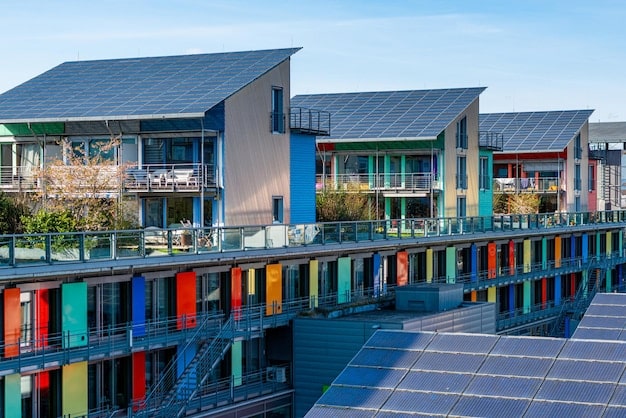The Future of Affordable Housing: Trends & Predictions for 2025

The Future of Affordable Housing: Trends and Predictions for 2025 and Beyond explores innovative solutions, technological advancements, and policy changes that aim to address the growing affordable housing crisis in the United States, offering insights into potential future scenarios.
Navigating the landscape of affordable housing can feel like an uphill battle. As we look ahead, understanding the emerging trends and forecasting future developments becomes crucial. This article, The Future of Affordable Housing: Trends and Predictions for 2025 and Beyond, unveils key insights into the evolving housing sector in the US.
Understanding the Affordable Housing Crisis
The affordable housing crisis is a pressing issue in the United States, impacting millions of individuals and families. Understanding the root causes and the scope of this crisis is essential to developing effective solutions. Several factors contribute to this complex problem, including stagnant wages, rising housing costs, and a shortage of available units.
Stagnant Wages and Rising Costs
For decades, wages for many Americans have failed to keep pace with the rising cost of living, particularly housing. This disparity makes it increasingly difficult for low- and moderate-income households to afford rent or mortgages. As housing costs continue to climb, a larger portion of income is allocated to housing, leaving less for other necessities like food, healthcare, and education.
Shortage of Affordable Units
The supply of affordable housing units has not kept up with demand. This shortage is due to several factors, including zoning restrictions, NIMBYism (Not In My Backyard) that opposes new construction in certain areas, and insufficient government funding for affordable housing projects. As a result, many families are forced to compete for a limited number of affordable units, driving up costs even further.

The consequences of the affordable housing crisis are far-reaching, affecting not only individuals and families but also communities and the economy as a whole. These consequences include increased homelessness, overcrowding, and housing instability, which can lead to poorer health outcomes, reduced educational attainment, and decreased economic productivity.
- Increased Homelessness: The lack of affordable housing is a primary driver of homelessness. Without stable housing, individuals and families struggle to maintain employment, access healthcare, and secure education.
- Overcrowding: When affordable housing is scarce, families often live in overcrowded conditions, which can lead to health and safety risks. Overcrowding can also strain resources and create social tensions.
- Housing Instability: Constant relocation due to unaffordable housing disrupts lives and communities. Children may have to switch schools frequently, and families struggle to build strong social networks.
Addressing the affordable housing crisis requires a multi-faceted approach that includes increasing the supply of affordable units, raising wages, and implementing policies that protect tenants and promote housing stability. Only through comprehensive solutions can we ensure that everyone has access to safe, decent, and affordable housing.
Innovative Housing Models and Technologies
In response to the affordable housing crisis, innovative housing models and technologies are emerging as promising solutions. These approaches aim to reduce construction costs, increase housing density, and promote sustainability. Among the most notable innovations are modular construction, 3D-printed homes, and micro-housing units.
Modular Construction
Modular construction involves building housing units off-site in a factory setting and then transporting and assembling them on-site. This method can significantly reduce construction time and costs compared to traditional building methods. Modular homes can be designed to be energy-efficient and customizable, making them an attractive option for affordable housing projects.
3D-Printed Homes
3D printing technology is revolutionizing the construction industry by offering a faster and more affordable way to build homes. 3D printers can create entire houses from materials like concrete or sustainable bio-based materials. This technology has the potential to dramatically lower construction costs and speed up the delivery of affordable housing units. Furthermore, 3D-printed homes can be designed to withstand natural disasters, making them a resilient housing option.

Micro-housing units are small, self-contained apartments designed to maximize space efficiency. These units typically range from 200 to 400 square feet and include a kitchen, bathroom, and living area. Micro-housing can be an affordable option for single individuals or couples, particularly in dense urban areas where land is expensive. To compensate for the small size, micro-housing developments often include shared amenities such as communal kitchens, lounges, and outdoor spaces.
- Reduced Construction Costs: Innovative technologies like modular construction and 3D printing can significantly lower the cost of building affordable housing units.
- Increased Density: Micro-housing and other high-density housing models allow for more efficient use of urban land, increasing the supply of affordable units in desirable locations.
- Sustainability: Many innovative housing models prioritize sustainability by incorporating energy-efficient designs, using eco-friendly materials, and reducing waste during construction.
These innovative housing models and technologies offer viable paths forward in addressing the affordable housing crisis. By embracing these approaches, communities can create more affordable, sustainable, and resilient housing options for their residents.
The Role of Policy and Government Initiatives
Government policies and initiatives play a crucial role in shaping the future of affordable housing. These policies can range from funding affordable housing programs to implementing zoning reforms that encourage denser and more diverse housing options. Effective government intervention is essential to addressing the systemic issues that contribute to the affordable housing crisis.
Funding Affordable Housing Programs
Government funding is a critical component of affordable housing development and preservation. Programs like the Low-Income Housing Tax Credit (LIHTC) and the Housing Choice Voucher Program (Section 8) provide financial incentives for developers to build or rehabilitate affordable housing units and help low-income families afford rent. Increased funding for these programs is essential to expanding the supply of affordable housing and reducing housing insecurity.
Zoning Reforms and Land Use Policies
Zoning reforms can play a significant role in promoting affordable housing by allowing for denser development and mixed-use zoning. Eliminating exclusionary zoning practices, such as single-family zoning, can open up more land for affordable housing development. Additionally, policies that streamline the permitting process and reduce regulatory barriers can help accelerate the creation of affordable housing units.
Public-Private Partnerships (PPPs) offer a collaborative approach to addressing the affordable housing crisis by leveraging the resources and expertise of both the public and private sectors. PPPs can take various forms, such as developers partnering with government agencies to build affordable housing on public land or investors providing capital for affordable housing projects in exchange for tax incentives or other benefits. These partnerships can help overcome financial and logistical challenges and accelerate the development of affordable housing.
- Increased Funding: Government funding is essential for supporting affordable housing development and preservation through programs like LIHTC and Section 8.
- Zoning Reforms: Zoning reforms can promote denser and more diverse housing options by eliminating exclusionary zoning practices and streamlining the permitting process.
- Public-Private Partnerships: PPPs leverage the resources and expertise of both the public and private sectors to overcome financial and logistical challenges in affordable housing development.
Government policies and initiatives are vital for creating a more equitable and affordable housing market. By prioritizing affordable housing in policy decisions and investing in programs that support its development and preservation, governments can help ensure that everyone has access to safe, decent, and affordable housing.
The Impact of Technology on Property Management
Technology is transforming the property management industry, offering new tools and platforms that streamline operations, reduce costs, and improve tenant experiences. The adoption of technology in property management can lead to more efficient management of affordable housing units and better outcomes for both landlords and tenants.
Online Rent Payment and Maintenance Requests
Online platforms for rent payment and maintenance requests simplify these processes for both landlords and tenants. Tenants can pay rent and submit maintenance requests online from anywhere, at any time, while landlords can track payments, manage maintenance requests, and communicate with tenants more efficiently. These platforms can reduce administrative burdens, improve cash flow, and enhance tenant satisfaction.
Smart Home Technologies
Smart home technologies, such as smart thermostats, lighting systems, and security devices, can help reduce energy consumption and improve the safety and security of affordable housing units. Smart thermostats can automatically adjust temperature settings based on occupancy and weather conditions, reducing energy waste and lowering utility bills. Smart lighting systems can be programmed to turn off lights when rooms are unoccupied, further reducing energy consumption. Smart security devices, such as video doorbells and security cameras, can enhance the safety and security of residents.
Data analytics can provide valuable insights into property performance, tenant behavior, and market trends. By analyzing data on rent payments, maintenance requests, and tenant demographics, property managers can identify areas for improvement, optimize operations, and make data-driven decisions. For example, data analytics can help property managers identify at-risk tenants who may need assistance with rent payments or connect tenants with resources and support services.
- Efficiency: Online platforms streamline rent payments, maintenance requests, and communication between landlords and tenants.
- Cost Savings: Smart home technologies reduce energy consumption and lower utility bills for both landlords and tenants.
- Data-Driven Decisions: Data analytics provide insights into property performance and tenant behavior, enabling property managers to optimize operations and improve outcomes.
Technology is revolutionizing the property management industry, offering tools and platforms that can enhance efficiency, reduce costs, and improve tenant experiences in affordable housing. By embracing technology, property managers can better manage their properties and provide safe, comfortable, and affordable housing for their residents.
Community-Based Solutions and Resident Empowerment
Community-based solutions and resident empowerment are essential components of successful affordable housing initiatives. These approaches recognize that affordable housing is not just about providing physical structures but also about creating vibrant, supportive communities where residents can thrive. By involving residents in the planning and management of affordable housing developments, communities can ensure that these developments meet the needs and aspirations of their residents.
Resident Participation in Planning and Management
Involving residents in the planning and management of affordable housing developments can lead to better outcomes for both residents and communities. Residents can provide valuable insights into the needs and priorities of the community, ensuring that developments are designed to meet those needs. Additionally, resident participation can foster a sense of ownership and pride in the community, leading to greater social cohesion and stronger social networks.
Community Land Trusts
Community Land Trusts (CLTs) are non-profit organizations that acquire land and hold it in trust for the benefit of the community. CLTs can use this land to develop affordable housing units that remain permanently affordable, ensuring that housing remains accessible to low- and moderate-income families in the long term. CLTs also provide residents with a voice in the management of the land and the development of affordable housing, promoting resident empowerment and community control.
Supportive services can enhance the lives of residents in affordable housing developments by providing access to resources and programs that promote health, education, and economic stability. These services can include on-site healthcare clinics, job training programs, childcare facilities, and financial literacy workshops. By integrating supportive services into affordable housing developments, communities can help residents overcome barriers to success and achieve their full potential.
- Meeting Needs: Resident participation ensures that affordable housing developments are designed to meet the needs and priorities of the community.
- Long-Term Affordability: Community Land Trusts maintain affordability by holding land in trust for the benefit of the community.
- Comprehensive Support: Supportive services provide residents with access to resources and programs that promote health, education, and economic stability.
Community-based solutions and resident empowerment are essential for creating successful affordable housing initiatives that not only provide safe and affordable housing but also foster vibrant, supportive communities where residents can thrive. By involving residents in the planning and management of affordable housing and providing access to supportive services, communities can help residents achieve their full potential and build stronger, more resilient neighborhoods.
The Future of Financing Affordable Housing
Financing affordable housing projects requires innovative approaches to meet the growing demand for affordable homes. As traditional funding sources may not be sufficient, exploring alternative financing mechanisms is crucial to support the development and preservation of affordable housing.
Impact Investing
Impact investing involves directing capital towards projects that generate both financial returns and positive social or environmental impact. In the context of affordable housing, impact investors can provide funding for the development of affordable housing units, the preservation of existing affordable housing, and the implementation of innovative housing models. Impact investing can attract new sources of capital to the affordable housing sector and help scale up successful initiatives.
Social Impact Bonds
Social Impact Bonds (SIBs) are a form of performance-based financing in which private investors provide upfront capital for social programs, and the government repays the investors only if the programs achieve pre-defined outcomes. In the context of affordable housing, SIBs can be used to finance programs that aim to reduce homelessness, improve housing stability, or increase access to affordable housing. If these programs achieve their outcomes, the government repays the investors with a return on their investment. SIBs can align financial incentives with social outcomes and encourage innovation in the delivery of affordable housing services.
Philanthropic contributions play a vital role in supporting affordable housing projects and initiatives. Foundations, corporations, and individual donors can provide grant funding for affordable housing development, supportive services, and community-based programs. Philanthropic contributions can help fill funding gaps, support innovative projects, and leverage additional public and private investment.
- New Sources of Capital: Impact investing attracts new sources of capital to the affordable housing sector and helps scale up successful initiatives.
- Performance-Based Financing: Social Impact Bonds align financial incentives with social outcomes and encourage innovation in the delivery of affordable housing services.
- Filling Funding Gaps: Philanthropic contributions help fill funding gaps, support innovative projects, and leverage additional public and private investment.
The future of financing affordable housing will likely involve a combination of traditional funding sources, innovative financing mechanisms, and philanthropic contributions. By exploring these approaches, communities can increase the availability of capital for affordable housing development and preservation and ensure that everyone has access to safe, decent, and affordable housing.
| Key Aspect | Brief Description |
|---|---|
| 🏠 Innovative Models | Modular construction & 3D-printed homes reduce building costs. |
| 🏛️ Policy Influence | Government initiatives & zoning reforms promote affordable housing. |
| 💡 Tech Integration | Technology streamlines operations and improves tenant experiences. |
| 🤝 Community Focus | Community-based solutions empower residents and foster supportive communities. |
[Frequently Asked Questions]
What are the primary challenges in providing affordable housing?
The main challenges include high construction costs, zoning restrictions limiting density, and insufficient funding for affordable housing programs.
How can technology help in making housing more affordable?
Technology like 3D printing and modular construction can reduce building costs, while smart home technologies can lower utility bills for residents.
What role do government policies play in affordable housing?
Government policies like funding programs, zoning reforms, and public-private partnerships are essential for promoting and supporting affordable housing initiatives.
What are community land trusts, and how do they help?
Community land trusts are non-profit organizations that acquire land and hold it in trust to ensure affordable housing remains accessible to low- and moderate-income families.
How can residents be involved in affordable housing projects?
Residents can participate in planning and management, provide insights into community needs, and foster a sense of ownership and pride in the community.
Conclusion
The future of affordable housing hinges on embracing innovative solutions, leveraging technology, and fostering community engagement. By addressing the challenges and capitalizing on emerging opportunities, we can strive towards a more equitable and accessible housing landscape for all.





